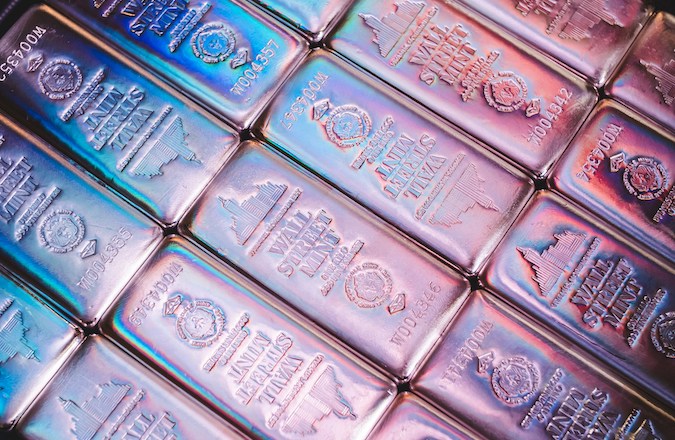As the global requirement for clean energy intensifies, efforts towards transitioning towards sustainable energy sources have picked up pace. Precious metals such as silver, platinum and palladium have emerged as crucial components in renewable energy technologies.
Figure 1: Wall Street Mint Silver Kilo bars by Scottsdale Mint in Arizona [1]
What are Precious Metals?
Precious metals are rare, naturally occurring metallic chemical elements of high economic value. Precious metals, particularly the noble metals, are more corrosion resistant and less chemically reactive than most elements, making them essential for modern technology and economic stability in industries such as electronic, medicine, aerospace, and renewable energy. The most well-known precious metals include:
- Gold
- Silver
- Platinum
- Palladium
- Rhodium
- Iridium
- Ruthenium
Silver: Powering Solar Innovations
Silver has a high electrical conductivity making it a key component in photovoltaic solar cells. It facilitates the efficient conversion of sunlight into electricity, serving as a conductive layer that transports electrons from the silicon wafers within solar panels to the external circuit. [2].
There is also ongoing research into the performance of photovoltaic silver paste, focusing on the shape to create a spherical silver powder. To date the research has shown that it has resulted in better dispersion and denser conductive films, in turn enhancing the performance of the solar cell.
Recent data indicates a significant uptick in silver demand from the solar industry as a result of these technological advancements. In 2023, the sector consumed approximately 142 million ounces of silver, nearly tripling its usage over the past decade. Industry experts project that silver demand from the solar sector alone could reach 8,000 metric tons annually by 2025, representing a 50% increase from current levels. [3].
Platinum Group Metals: Catalysts in Hydrogen Energy
Platinum and palladium, members of the platinum group metals (PGMs), are essential in producing, distributing, storing and utilising green hydrogen.[4].
With the increased demand for clean energy comes the increased demand for a stable grid; to accommodate the addition of renewable energy, the grid must be balanced. Platinum and iridium coatings can be used as catalysts in the electrolysis process used to produce green hydrogen, which can then be stored and utilised when the grid needs extra supplies.
Green hydrogen produced from renewable-powered electrolysis can also be used as a zero-carbon transport fuel when run through a fuel cell (which combines hydrogen and oxygen via PGM catalysts to produce electricity). This is especially relevant for sectors such as heavy-duty trucks which are more difficult to decarbonise where the vehicles are not suited to batteries, as well as marine and aviation applications which require energy dense fuels.
Challenges and Sustainability Considerations
While the integration of precious metals in renewable energy technologies offers substantial environmental benefits, it also presents challenges related to supply constraints and environmental impacts associated with mining. To address these concerns, the industry is focusing on sustainable mining practices, recycling initiatives, and the development of technologies that require lower metal loadings without compromising efficiency.
About Pager Power
Pager Power undertakes technical assessments for developers of renewable energy projects and tall buildings worldwide. For more information about what we do, please get in touch.
References
[1] Scottsdale Mint (May 2021) from Unsplash.com. Last accessed on 18th March 2025. Available at: https://unsplash.com/photos/blue-and-white-floral-textile-rQ36_ZtZedo
[2] https://esgold.com/the-role-of-precious-metals-in-the-green-transition/?utm_source=chatgpt.com
[3] https://www.jpost.com/business-and-innovation/precious-metals/article-826328




